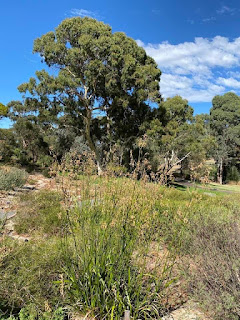The Wittunga Botanic Garden is a botanical garden dedicated to plants that grow in this and like regions. It’s well-laid out, and on Tuesday mornings, one can take a tour of the gardens, led by Helen, who quite obviously loves every part of them. The plot was once a farm and orchard, developed by farmer Edwin Ashby in 1902. The name means “beside water”, and it’s situated
around a billabong (stagnant pool) and a lake, where water used to trickle from an uphill spring. Ashby was ahead of his time in studying agriculture and plants, so there are some interesting and beautiful species. In the seventies, his son Keith donated the land, along with some of his and his father’s gardens, to the city.
 |
| Helen points out the Blood Lilies |
The most imposing part of the park is the number of species of eucalyptus or gum trees. One of the oldest trees on the planet, it has evolved to at least 800 different species! While they’re invasive in Spain and the US, they are welcome here, although they do cause a problem when bush fires happen, exploding like bombs because of the oil in its leaves and wood. Interestingly, the oldest fossils of the eucalyp are found in South America, although the tree no longer grows there.
Some of the different types of eucalyptus trees
A small part of the garden is dedicated to plants grown in the Fynbos region of South Africa, from Cape Town to Port Elizabeth (a route we took when we were there). It seems they have a similar climate to South Australia, so it’s a good place to showcase plants from that area, like the protea, the iconic South African flower.
Other areas feature Australian wetland plants, plants native to Kangaroo Island, endangered plants from the deserts of Western Australia, and the Gondwana Trail, which displays ancient plants left in the area when the continent split and drifted apart.
It’s a great place to wander, explore, and listen to birds—but not Ted’s dreaded noisy miners!
About four blocks away is the Colebrook Reconciliation Park. Colebrook was one of those horrible homes where indigenous children, taken from their parents, were placed in order to “anglicize” them, as part of the United Aboriginal Mission. Colebrook itself began in other areas of the state, and was headed by Sister Ruby and Sister Della, who were said to be very kind to the children. In 1953, after it had moved to Eden Hills, a series of strict superintendents took over.
From 1943-1972, almost 140 children were removed from their parents, never to see them again. They lost ties not only to their families and ancient customs, but to the land as well. In 1972 the home was closed, and in 1973, the building was razed, but the scars remain. A good movie to get a sense of this is Rabbit Proof Fence.
In May of 1997, local officials of this area issued an apology, but Prime Minister Kevin Rudd’s apology didn’t happen till 2008.
Colebrook Reconcilation Park, built on the old location just a few short years ago, was an effort of several groups to remember and honor the “Stolen Generation”.
There is a heartrending statue called “The Grieving Mother,” with empty arms (someone placed flowers there with the sad note stating that nothing has changed), and a “Fountain of Tears” has water flowing over the faces of Aboriginal elders. There are trees and rocks, and one of the most moving additions is a series of “listening posts”, painted by local schoolchildren with the help of Carly Takari Dodd, of Aboriginal decent. Press a button and you can hear stories from some of those who lived there.
It’s hard to walk away without tears in your eyes, especially remembering that situations much like it occurred in the US and Canada.










No comments:
Post a Comment